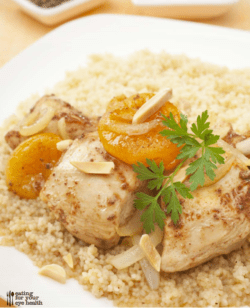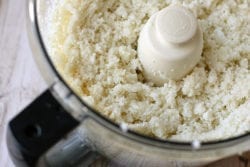Ingredients:
- 675g skinless boneless chicken, cut into large chunks (use a mixture of breast and thigh meats)
- 1 tablespoon olive oil
- 1 medium onion, finely chopped
- Spices – 1 level teaspoon ground ginger, 1 level teaspoon cinnamon, 1 level teaspoon ground coriander, 1 level teaspoon turmeric, 1 level teaspoon ground cumin, pinch of chilli powder or flakes
- 1 tablespoon tomato puree
- 568ml (1 pint) chicken stock
- 1 small orange, zested and juiced
- 150g mixed dried fruit e.g. apricots, cranberries, raisins, sultanas
- 2 tablespoons fresh coriander, roughly chopped, to garnish
Method:
- Heat the oil in a large casserole pot over a gentle heat.
- Add the onion and ground spices, and cook until onion is soft (about 5 minutes).
- Add the chicken, and tomato puree and stir to ensure all pieces are coated in the spice mixture.
- Then add the remaining ingredients (orange zest and juice, dried fruits and chicken stock). Bring to the boil, then reduce the heat and cover the pan, allowing to simmer gently for 30 minutes until the chicken is tender with juices running clear, the sauce has reduced slightly and the fruits are plump and soft. Add salt and pepper to taste.
- Stir through the chopped coriander before serving.
- Serve with couscous , but remember to count the carbohydrates or choose a lower carb side with Cauliflower Rice below. Couscous and Cauliflower not included in Nutritional Analysis.
| NUTRITIONAL ANALYSIS PER SERVING Tangine:
|
||
| Energy (kcal) 343 | Carbohydrate(g) 31.0 | Fat (g) 11.6 |
| Energy (kJ) 1449 | Sugars (g) 29.4 | Saturates (g) 2.7 |
| Protein (g) 39.5 | Sodium (mg) 444 | Fibre (g) 1.7 |
| Salt equivalent (g) 1.1 | ||
Cauliflower Rice
If you are looking to use fewer carbohydrates, why not give a current trend a go? ‘Cauliflower rice’ is all the rage! An 80g portion counts towards your daily 5-7 portions of salads, vegetables and fruit. All you need is a grater or food processor to make rice-like pieces, which can then be microwaved, pan-fried or roasted to create a light, fluffy vegetable dish or carbohydrate substitute.
Here’s how to go about it:
Step 1:
Blitz – a food processer gives the best results. Remove the outer leaves from the cauliflower, cut it into quarters and remove most of the thick core, then cut each quarter into two or three chunks. Using 1/3 or ½ the cauliflower at a time, blend for 30 seconds or so, until the cauliflower resembles fine rice, or couscous.
Or
Grate – If you don’t own a food processer, you can grate the raw cauliflower on the coarse side of the grater. You may find you’re left with a few bigger pieces, which will give the resulting ‘rice’ a chunkier texture.
Step 2:
Cook using one of the following three options:
- Roasting gives a good flavour. Toss the rice in a drizzle of rapeseed or olive oil in a tray, then spread it out to a thin, even layer. Roast the ‘rice’ at 200C for 12 minutes, mixing it in the tray halfway through cooking. This dries the rice out, giving it a light, fluffy texture.
- Or try stir frying in a little rapeseed or olive oil for 5 mins. If your ‘rice’ is on the chunky side, you may need to allow a little longer cooking time.
- Or you can microwave fresh cauliflower rice in a heatproof bowl, covered with cling film, for three minutes on High power. Stir, and leave to stand for 1 minute. If your ‘rice’ is on the chunky side, you may need to allow a little longer cooking time.
Step 3:
Eat and enjoy!
Note: If you swop out carbohydrates such as rice or pasta for cauliflower rice, and are counting carbohydrate as part of your diabetes care, don’t forget to adjust your insulin treatment accordingly. Your diabetes care team can provide you with guidance as needed.



